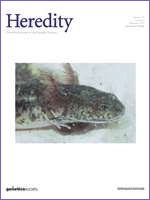Special Issue on Celebration of the 50th Anniversary of the Population Genetics Group Meeting |
|  | | The Population Genetic Group meetings have been a key forum in the last half century for discussion of the maintenance and distribution of genetic variation in natural populations, the genetic basis and evolution of quantitative traits, mechanisms of adaptation, sexual selection and speciation, and much more. The small selection of papers in this Special Issue illustrates the diversity and vibrancy of the 'PopGroup' community and helps to mark this anniversary.
Guest Editors:
Roger Butlin, Department of Animal and Plant Sciences, The University of Sheffield, Sheffield, UK; Department of Marine Sciences, University of Gothenburg, Gothenburg, Sweden
John Brookfield, School of Life Sciences, The University of Nottingham, University Park, Nottingham, UK |  | TABLE OF CONTENTS
|  |  |  | Volume 118, Issue 1 (January 2017) |  | In this issue
 Editorial Editorial
 Reviews Reviews
 Original Articles Original Articles
 Corrigendum Corrigendum
Also new
    AOP AOP | |  |  | Editorial |  Top Top |  | Genetic variation, selection and evolution: special issue in celebration of the 50th anniversary of the population genetics group meetingR K Butlin and J F Y Brookfield Heredity 2017 118: 1; advance online publication, November 9, 2016; 10.1038/hdy.2016.97 Full Text | PDF |  | Reviews |  Top Top |  | Population genetics from 1966 to 2016 OPENB Charlesworth and D Charlesworth Heredity 2017 118: 2-9; advance online publication, July 27, 2016; 10.1038/hdy.2016.55 Abstract | Full Text |  |  |  | Heritable symbionts in a world of varying temperatureC Corbin, E R Heyworth, J Ferrari and G D D Hurst Heredity 2017 118: 10-20; advance online publication, October 5, 2016; 10.1038/hdy.2016.71 Abstract | Full Text |  | Original Articles |  Top Top |  | What explains rare and conspicuous colours in a snail? A test of time-series data against models of drift, migration or selection OPENK Johannesson and R K Butlin Heredity 2017 118: 21-30; advance online publication, September 21, 2016; 10.1038/hdy.2016.77 Abstract | Full Text |  |  |  | Evolution of nickel hyperaccumulation and serpentine adaptation in the Alyssum serpyllifolium species complexM K Sobczyk, J A C Smith, A J Pollard and D A Filatov Heredity 2017 118: 31-41; advance online publication, October 26, 2016; 10.1038/hdy.2016.93 Abstract | Full Text |  |  |  | Uncovering the genetic signature of quantitative trait evolution with replicated time series dataS U Franssen, R Kofler and C Schlötterer Heredity 2017 118: 42-51; advance online publication, November 16, 2016; 10.1038/hdy.2016.98 Abstract | Full Text |  |  |  | What causes mating system shifts in plants? Arabidopsis lyrata as a case study OPENB K Mable, J Hagmann, S-T Kim, A Adam, E Kilbride, D Weigel and M Stift Heredity 2017 118: 52-63; advance online publication, November 2, 2016; 10.1038/hdy.2016.99 Abstract | Full Text |  |  |  | Inbreeding depression by environment interactions in a free-living mammal population OPENJ M Pemberton, P E Ellis, J G Pilkington and C Bérénos Heredity 2017 118: 64-77; advance online publication, November 23, 2016; 10.1038/hdy.2016.100 Abstract | Full Text |  |  |  | The comparative landscape of duplications in Heliconius melpomene and Heliconius cydno OPENA Pinharanda, S H Martin, S L Barker, J W Davey and C D Jiggins Heredity 2017 118: 78-87; advance online publication, December 7, 2016; 10.1038/hdy.2016.107 Abstract | Full Text |  |  |  | DNA sequence diversity and the efficiency of natural selection in animal mitochondrial DNAJ James, D Castellano and A Eyre-Walker Heredity 2017 118: 88-95; advance online publication, November 9, 2016; 10.1038/hdy.2016.108 Abstract | Full Text |  |  |  | How does epistasis influence the response to selection?N H Barton Heredity 2017 118: 96-109; advance online publication, November 30, 2016; 10.1038/hdy.2016.109 Abstract | Full Text |  | Corrigendum |  Top Top |  | What causes mating system shifts in plants? Arabidopsis lyrata as a case study OPENB K Mable, J Hagmann, S-T Kim, A Adam, E Kilbride, D Weigel and M Stift Heredity 2017 118: 110; advance online publication, December 7, 2016; 10.1038/hdy.2016.122 Full Text | PDF |  |  |  |  |  |  |  |  |  |  | Natureevents is a fully searchable, multi-disciplinary database designed to maximise exposure for events organisers. The contents of the Natureevents Directory are now live. The digital version is available here.
Find the latest scientific conferences, courses, meetings and symposia on natureevents.com. For event advertising opportunities across the Nature Publishing Group portfolio please contact natureevents@nature.com |  |  |  |  |  | |  | Please note that you need to be a subscriber or site-licence holder to enjoy full-text access to Heredity. In order to do so, please purchase a subscription. You have been sent this Table of Contents Alert because you have opted in to receive it. You can change or discontinue your e-mail alerts at any time, by modifying your preferences on your nature.com account at: www.nature.com/nams/svc/myaccount (You will need to log in to be recognised as a nature.com registrant). For further technical assistance, please contact our registration department. For print subscription enquiries, please contact our subscription department. For other enquiries, please contact our customer feedback department. Nature Publishing Group |One New York Plaza, Suite 4500 | New York | NY 10004-1562 | USA Nature Publishing Group's worldwide offices:
London - Paris - Munich - New Delhi - Tokyo - Melbourne
San Diego - San Francisco - Washington - New York - Boston Macmillan Publishers Limited is a company incorporated in England and Wales under company number 785998 and whose registered office is located at The Campus, 4 Crinan Street, London, N1 9XW. © 2016 Nature Publishing Group, a division of Macmillan Publishers Limited. All Rights Reserved. |  | | |
| |
No comments:
Post a Comment